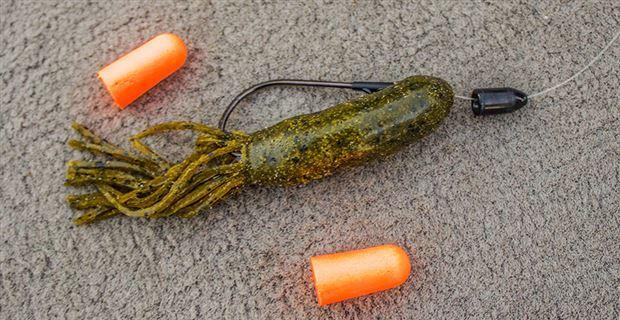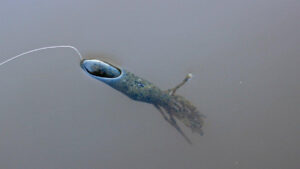Tubes are some of most versatile soft-plastic bass fishing lures available to anglers and they’re eadily eaten by all three species of bass: Spotted bass, smallmouth bass and largemouth bass. These baits can also be fished a number of different ways.
By inserting foam into the cavity of the tube—regardless of your preferred presentation—you’re able to take things to an entirely different level.
Inserting the foam
You can use any foam you can get your hands on for this process. I know anglers who tear off small pieces of foam from pool noodles or use packing peanuts. I personally use foam earplugs. They come out of the package the size I need them and are easy to work with.
Gently stretch the bottom of the tube so it doesn’t tear and carefully push the piece of foam into the hollow body cavity. Foam earplugs are very pliable and can be compressed without losing their buoyancy, which makes this process even easier.
I generally use just one earplug but you can add up to three. Two or more earplugs will make your tube float if rigged weightless, which should be taken into account when adding any foam. The tube will look no different from the outside and can be added to any traditional tube setup.
I’ve never experienced any negatives from the foam interfering with hook penetration on a hookset. This process can, however, weaken the soft plastic and you may end up going through more baits throughout the day. But I think that’s a worthy trade-off if the bass are eating your offerings.
How to fish it
A foam-stuffed tube will work with any traditional tube application barring a jighead rig, but I’ve found the most success using a Texas rig or Carolina rig.
Texas rig
I first became aware of this tackle tweak when fishing for spawning bass on a bed. They were unwilling to eat my Texas rigged craws or worms, but when my boater tied on this setup, the bass couldn’t resist it.
When using a light bullet weight the foam slows down the tube’s already enticing movement, overemphasizing the glide of the bait as it sinks to the bottom. This action drives a bedding bass crazy but can be equally as effective on pressured bass that have seen a lot of lures.
The foam-tube can be fished with a heavy Texas rig, too. The action is completely different when rigged with a 1/2-ounce weight or heavier, but still catches plenty of fish. With a heavy weight you can allow your tube to float up off the bottom if you give your line some slack after your weight hits the bottom. This gives off a similar look as a drop shot but you can use heavier line and put your lure into heavy cover without concern.
Carolina rig
Outside of spawning season, a Carolina rig is my favorite way to fish a tube. As bass begin to move towards deeper water there are few methods more tried and true than the ball and chain. If the bass in your area are being finicky, try adding a foam-filled tube to your C-rig.
The heavy weight will pull the tube down while the foam forces the lure to suspend off the bottom. As the rig is dragged back to the boat the tube will randomly dart from side to side. The action this puts off is impressive and can fire up a school or a single bass that won’t to commit to traditional offerings.
Throw a package of earplugs in your tacklebox before the next time you head to the lake. You’re not reinventing the wheel, but adding small pieces of foam to a tube gives an already exceptional lure a unique movement that can result in more fish.
















